Bowls Club
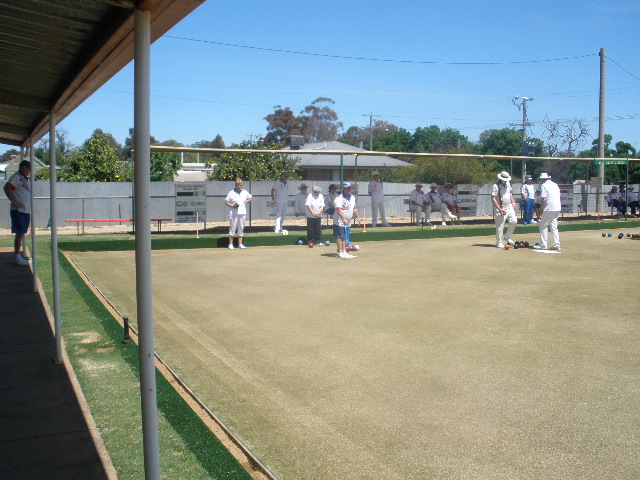
Information courtesy Lola Clarke (life member)
The St James Bowls Club started in 1964 after sir George Coles of G.J.Coles purchased a large parcel of land off the Kelly brothers and donated it to the town to establish sporting facilities.We joined the club approximately in 1984, this happened because a gentleman called Wes Medley saw us looking over the fence watching social bowls one Saturday afternoon. His words were, “this game of bowls is a good one, you should try it”, we did and we were hooked.
When we first joined the club there was no phone and against the advice of some older members who said it wasn’t necessary as they had done without it for twenty years, it was voted in that the club should have one and it was duly installed. Along the way we had an upgrade of the kitchen with hot water installed to the sink and new cupboard. Later again the new toilets after a grant had been given by the shire to replace the old red brick toilet block which was also for the use of the public. We had ladies, men’s and even a disabled toilet that also featured a shower facility. Further upgrades included new lights above the bowling green, new shades and seating and the concrete paths being given a new non slip surface. Other upgrades were a bar so people could stay after bowls to enjoy a drink with their mates in air conditioned comfort, another asset.
Over some thirty four years as members we played Pennant and all the other events the club ran. Each of us contributed to the running of the club by way of being Presidents, secretaries, on match and selection committees plus Stan assisted veteran greenkeeper Bert Roberts by mowing the green twice a week over many years. Stan Clarke was also assistant or manager of the sixty and over men’s group of the club which was very popular with our club men.The club’s aim was to be inclusive of all, young or old, new members or visitors alike. The club always tried to send a team or more to other clubs tournaments as if you don’t support their days you could hardly expect them at your club when you have a day on.
Each season we would have at least two men’s tournaments, two ladies tournaments and one mixed event. The club also played night pennant, Saturday pennant and Tuesday pennant plus two sixty and over days. There was also a past President’s association in the area and St James was lucky enough to be able to have a day on the green for that also. Our club had a reputation for some of the best afternoon teas and lunches as the ladies of the bowls clubs were very good cooks, especially their sponge cakes, nearly everyone had Elma Old’s “no fail” sponge recipe.In earlier years we had 1 A Grade team needing sixteen platers and 1 B Grade team needing twelve. The last couple of years it was 2 B Grade teams needing a total of twenty four players on Saturdays and one midweek team of twelve players.
The Club has had many successes but of note are the three District presidents who came from St. James Bowls. The first was in Betty Lidgerwood. The second was in Dorothy Hooper. The third was Lola Clarke. St James also fielded an international judge in Kerry Ralph. Massive achievements for a little club.
CFA
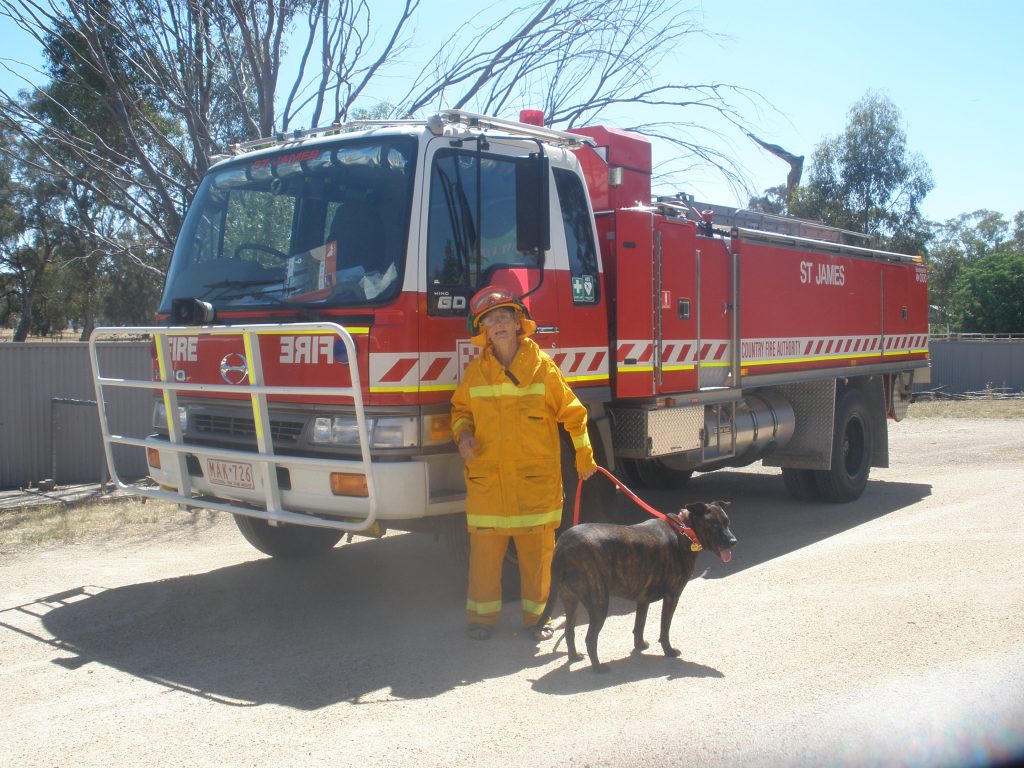
Information courtesy Kathie Beattie
The Urban Brigade started in 1911, was de-registered in 1932, but continued to give protection for a further 12 years. The Country Fire Authority Act was passed by the Government in 1944. The St James and District Fire Brigade was formed in 1942 and was serviced by members from Lake Rowan, Almonds, Yundool and St James. Their service continues to-day under the control of Region 22 Head Office.
Community Club

The St James Community Club is a morning tea/coffee group for all locals and visitors which commenced on 3rd March 2017. It meets at the St. James Hall every second Thursday and there is no format or purpose other than a social get together.
About 10 to 20 people attend and enjoy their favourite brew, coffee (cappiccino, flat white, long black) or tea along with goodies like scones, cakes, slices, fruit or chocolate.
It is a time to relax, enjoy each other’s company and have a bit of a giggle. Join us some time when you are passing.
Golf Club
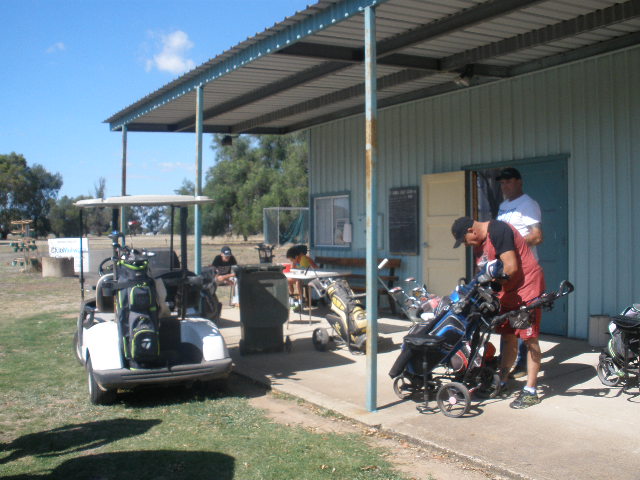
Information courtesy Keith Woods (life member)
St James Golf Club members were playing in Mr Kelly’s paddock back in the nineteen forties. There were no fairways. The sand scrapes were in an open space between the existing trees. Wire fences were built around the scrapes to keep off the sheep but not the cattle. Players stepped over the wire to putt. At the “St James Back-to” Sir George Coles was conversing with Mr Ned Pelly and Merv Finch. Sir George asked if there was anything St James town and district needed. He was told that there was no public sports arena as clubs now played on private land. It was this discussion that led to Coles donating the area where golf is now played.
The golf club held meetings in the hotel. Each committee member drew a plan for a nine hole course. From these plans were drawn up the present layout. Working bees were held to build the sand scrapes and plant trees. Originally when we started playing a cow bail was used as the original office to check the cards. The clubhouse we now have was originally one room of Benalla Technical School. We bought, pulled down, stored it in a grain shed in the railway yards at St James for quite a few years (total unknown). When the clubhouse was reassembled it was done entirely via a series of working bees which utilised the help of some generous souls who were not even members of the golf club.
Gun Club
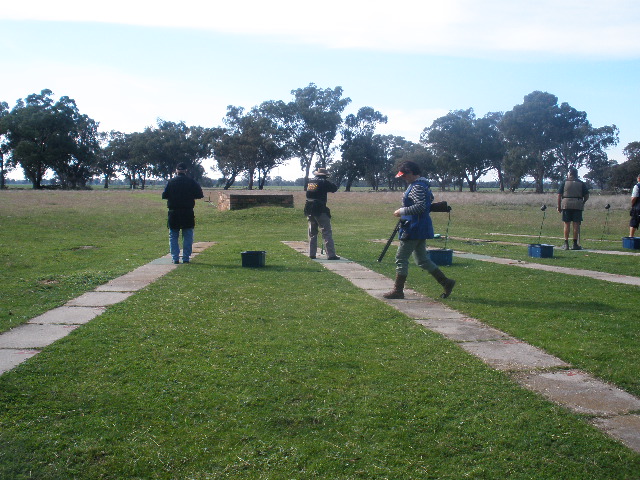
Information courtesy Jim Kelly (President)
After a lapse during World War Two the St James Clay Target Club re formed in 1946. The President was Harry Pettit, Secretary Bert Roberts or Maurice Murphy. Others were Phil Pettit, Alan Church, Alf Parker, Harold Walter, Jack Cruse, Jack and Gerry Kelly. Champion shooters Vin Ryan, Albert Boyd and Alby Wright.
The club operated in Kelly’s paddock, now the site of the St James Golf Club.
There was one ‘snipe’ trap which was usually operated for clay targets plus a set of five live bird traps. Pigeons, starlings, sparrows and galahs were used.
The pigeons were mainly supplied by Alby Wright while the other birds were netted in the wild. The starlings and sparrows were supplied by Alf Jordan from Shepparton.
There were three or four ‘bird boys’ and we would be handed the birds and as soon as the referee gave his decision we would run out, re set the trap, pop the bird in and scurry back.. Should one of us lose a bird, woe betide. Only senior boys were allowed to handle the pigeons as they were too valuable to lose. Galahs of course needed gauntlets to handle them.
Bookmakers speculated on live birds, it would be nothing for a shooter to have 200 pounds ($400.00) riding on his skill. Birds had to be shot dead within a boundary fence.
The late Bert Roberts was one of the best live bird shooters in Australia. Pressure never seemed to affect him.
Phil Pettit senior was another top shooter, one of the best field shooters I (Jim Kelly) have ever seen.
The club continued its activities at the golf club until the nineteen sixties.In 1977 a ‘back to’ was organized and that fired us up and we cleared a site North East of our present location where we installed a temporary layout. The shoot was highly successful and we continued there until we moved to our present site.
We took over the previous football, cricket and golf club shed, installed permanent traps and trap rouses, laid on power, extended the club house and other miscellaneous tasks.
We have two Gemini automatic traps with phono release so our set up is excellent. With an air conditioned clubhouse and under cover seating our club is capable of hosting State and Commonwealth titles.
We shoot whenever there are five Saturdays in the month. Being an accredited shooting ground we can have training, come and try days and social groups are welcome. We are registered with Australian Clay Target Association and so our members are able to compete Worldwide.
Red Cross
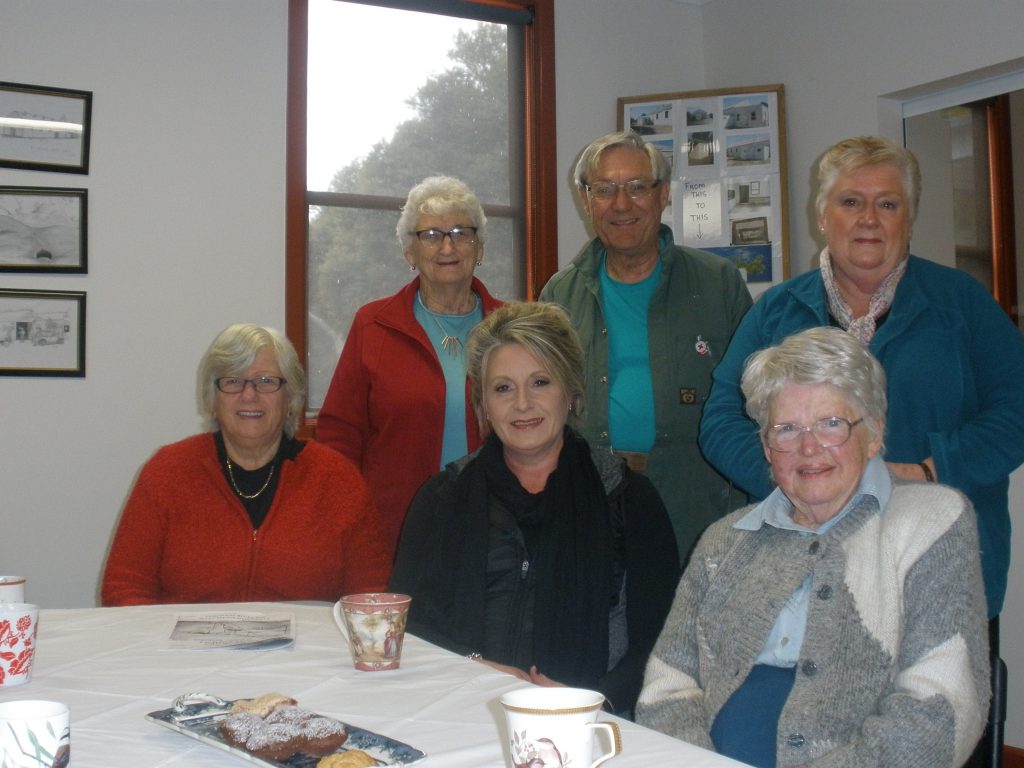
Information courtesy Diane Young
St James Red Cross Branch was formed In September 1939 after World War 11 broke out. Meetings were held fortnightly to coincide with Stock Sales. Afternoon tea was served for 6 pence a head. Each Red Cross Day two members gave their time to go around and collect whatever people could afford to give.
The Vacuum Oil Company held picture nights with all takings going to Red Cross. Twenty one pounds four shillings and seven pence was raised at a Radio Party.One year Red Cross was running a junior competition and our branch entered baby John Parker who was the lucky winner (that was about 75 years ago)!
Stalls were held at meetings and we catered for many farm sales. Balls were held with a Belle of the Ball, entry for men was 3/- and for ladies 2/-. Food for Britain was collected, clothes were made for Bonegilla Migrant Camp. Raffle books were always well patronised.An appeal was held district wide each year in aid of Red Cross, every year about four members would undertake the job. We also held card nights. At conference each year for many years a competition for the most number of articles produced was held and on three occasions St James won this. When it was our turn to host conference we supplied morning tea, lunch and afternoon tea for a nominal charge.
We knitted knee rugs, bed socks and capes. Also sent to Headquarters were good used clothing, eggs and citrus fruits. In 1969 -70 Head Quarters held a March Fair and we contributed goods to this. For many years our Branch held an annual Casserole Luncheon as our main fund raiser, but due to small numbers we held our last luncheon in 2004. We sold Canoe Marathon tickets for forty years until in 2008 Red Cross decided to end their involvement. We sold Major Raffle tickets for many years but it is all done online now.
We still do Red Cross Calling each year. It is our only fundraiser these days but we still manage to collect around $700 each year. The St James Hall has been the venue for all of our functions over the past eighty years.